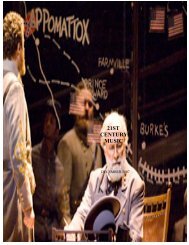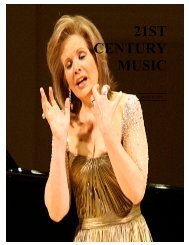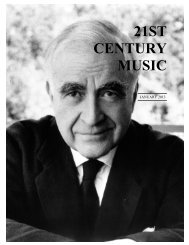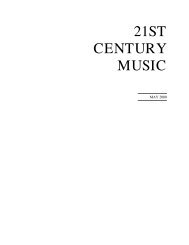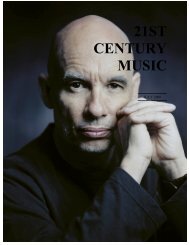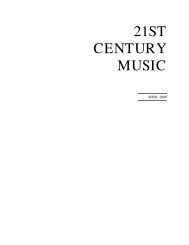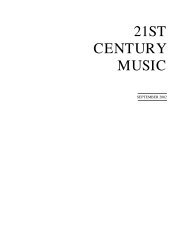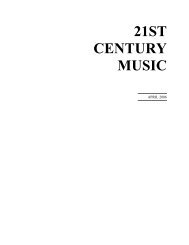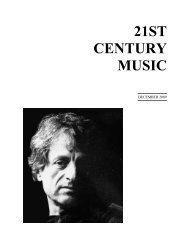You also want an ePaper? Increase the reach of your titles
YUMPU automatically turns print PDFs into web optimized ePapers that Google loves.
In the early 1940's, he met the Boston painter Hyman Bloom,<br />
who not only influenced Hovhaness's growing interest in<br />
ethnic motifs but also introduced him to Yenouk Der<br />
Hagopian, a troubadour Armenian folksinger. His other<br />
important friend during this period was Hermon DiGiovanno,<br />
a "clairvoyant" painter also known as Emalaus Ionidies, who<br />
stimulated Hovhaness's continuing interest in extrasensory<br />
phenomena. From such different artistic experience would<br />
inevitably come musical compositions contrary to the common<br />
run.<br />
Thanks to 1944 Boston concerts sponsored by Armenian<br />
organizations, Hovhaness produced several new compositions<br />
reflective of Armenian music, including Lousadzak (1944), the<br />
opera Etchmiadzin and Armenian Rhapsody No. 1 (which<br />
incorporates a Der Hagopian melody), among others. He<br />
collaborated with an Armenian student group in co-sponsoring<br />
annual New York concerts of his music, beginning with one at<br />
Town Hall in June 1945. The composer Lou Harrison, then a<br />
music critic for the New York Herald-Tribune, came to review<br />
it. Having an extra ticket, Harrison invited his friend John<br />
Cage, also then a young composer.<br />
As Harrison remembered it, "Here came this new name to us.<br />
We sat through the first piece and were quite startled. It was<br />
Lousadzak, which comes up from the cellos and then the piano<br />
comes in. It was beautifully played. We said to each other that<br />
the second one would start with an oompah, and it didn't. I<br />
think it was Tzaikerk. During the intermission, we went out all<br />
excited, because it was clear the music was going to go on<br />
doing this. As I remember, the hall was absolutely full."<br />
What Harrison found in the lobby "was the closest I've ever<br />
been to one of those renowned artistic riots. The Chromaticists<br />
and the Americanists were carrying on at high decibels. What<br />
had touched it off, of course, was the fact that here came a<br />
man from Boston whose obviously beautiful and fine music<br />
had nothing to do with either camp and was, in fact, its own<br />
very wonderful thing to begin with." And it has been that way<br />
ever since.<br />
Harrison's review was laudatory, identifying Hovhaness as "a<br />
composer of considerable interest and originality." Harrison<br />
also recalls, "There was a beautiful innocence about Alan.<br />
There always has been, but it was very pronounced in those<br />
days." Cage introduced Hovhaness around artistic New York<br />
and wrote favorably about his work in the June 1946 issue of<br />
Modern <strong>Music</strong>. Unable to survive financially in New York,<br />
Hovhaness returned home, where in 1948 he began three years<br />
of teaching at the Boston Conservatory of <strong>Music</strong>, the smaller<br />
music school in his home city. Aside from three years at<br />
Eastman (Rochester) summer school in the mid-1950's, that<br />
was his last regular teaching position.<br />
Around 1953, his work received greater professional<br />
recognition. The Guggenheim Foundation awarded him the<br />
first of two successive fellowships. Martha Graham<br />
commissioned a score for her dance company, and the<br />
Louisville Orchestra another piece for its own premiere<br />
concert series. Hovhaness met the conductor Leopold<br />
Stokowski, who had been programming Hovhaness<br />
composition since 1942; and the conductor commissioned the<br />
composer's Mysterious Mountain (1955) for an inaugural<br />
concert with the Houston Symphony. "He asked me first to<br />
write a fanfare for brass to be played to introduce the concert,<br />
but when he saw I'd written a fanfare to a mysterious<br />
mountain, he asked me to write a big piece."<br />
In 1959, in his own late 40's, Hovhaness began the second<br />
phase of his musical education. He received a Fulbright<br />
Research fellowship to study Karnatic music in South India.<br />
He visited Japan for the first time, giving well-received<br />
concerts of his own works, and returned in 1962-63 to study<br />
gagaku music, which he describes as "the earliest orchestral<br />
music we know; it came from China and Korea in the 700s."<br />
He learned to play Japanese instruments, such as the oboe-like<br />
hichiriki and the complex mouth organ sho, and even<br />
performed with a gagaku group. By 1965, Hovhaness could<br />
sharply distinguish himself from his contemporaries by<br />
writing that his principal musical preferences were "7thcentury<br />
Armenian religious music, classic music of South<br />
India, Chinese orchestra music of the Tang Dynasty, Ah-ak<br />
music of Korea, gagaku of Japan, and the opera-oratorios of<br />
Handel."<br />
The composer was tall and slender, with doe-like brown eyes<br />
and a broad mustache over a wide mouth. A scraggly gray<br />
beard framed his slender, essentially handsome face, and skin<br />
once mottled from acne had, amazingly, become clear. His<br />
wavy hair had turned gray, and he wore it long enough to fluff<br />
out from the back of his head. He had always looked<br />
physically frail; but when I saw him then, recovering from a<br />
broken hip, he looked no less frail than before. The last of<br />
several wives, Hinako (HEE-na-ko) Fujihara is short, slight,<br />
and dark-haired, perhaps a quarter-century younger than her<br />
husband; they have been together for 15 years. As she is also<br />
very efficient at finding papers related to his career, it is not<br />
for nothing that their personal publishing company and record<br />
label are both called Fujihara.<br />
16



